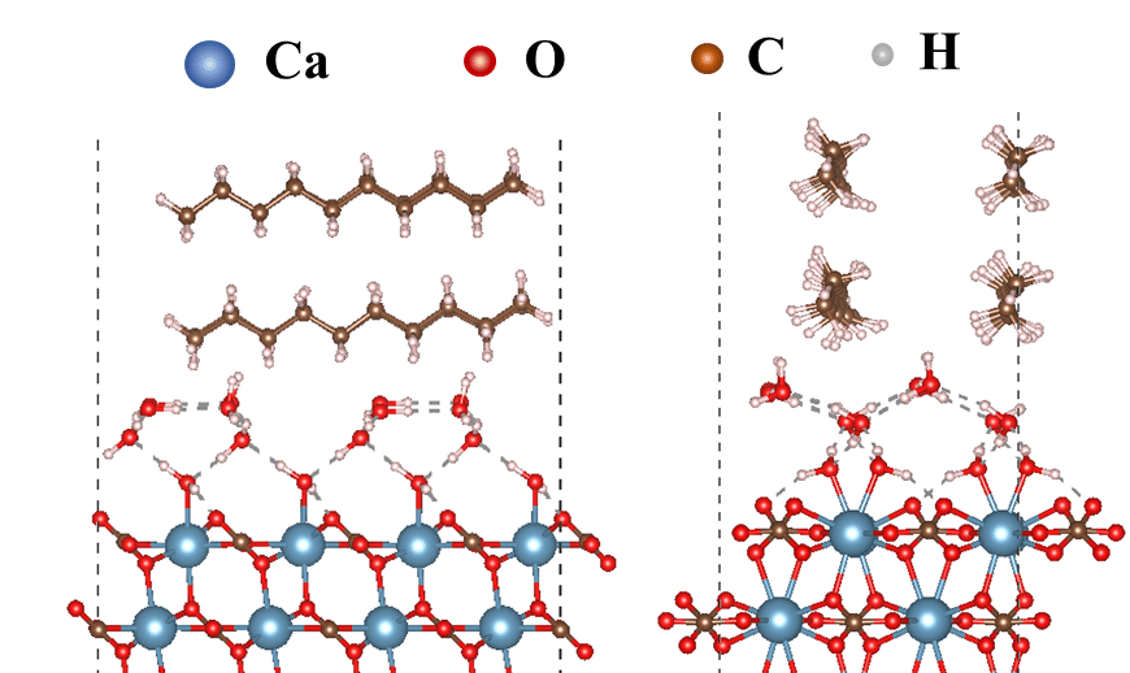
New simulations of the interactions between oil, water and rock at the quantum level could help solve giant reservoir problem
Over half of the oil in the UAE’s hydrocarbon reservoirs is trapped underground in tiny rock pores. Despite the millions of barrels of oil produced every day in the UAE, extracting this crude oil efficiently and sustainably has proven extremely difficult.
Now, researchers at Khalifa University have discovered a way to analyze how this oil and water interacts with reservoir rock at the quantum level, providing detailed information about how multiphase fluids – fluids with a combination of liquids, like oil and water – move along mineral surfaces, revealing the key role of temperature and a characteristic called wettability.
This new understanding might improve productivity of the UAE’s oil wells and help Abu Dhabi reach its goal of increasing oil recovery rates to 70%.
The new results are published in the Journal of Physical Chemistry C in a paper by Dr. Tiejun Zhang, Associate Professor of Mechanical and Materials Engineering, with first authors Dr. Jin You Lu and PhD student Qiaoyu Ge, as well as Research Scientist Dr. Aikifa Raza.
“Crude oil is a complicated mixture. While it’s mostly hydrocarbons, crude oil has a range of hydrocarbon fractions, and it interacts with both formation water and reservoir rock, which have a variety of minerals. How this diverse oil-water mixture flows through carbonate rock pores has been difficult to observe and capture in scientific detail, until now,” Dr. Zhang said.
His team developed a density functional theory (DFT) simulation technique as a way to reveal what’s happening in these subterranean fluid flows down to their molecular interactions with rock. DFT is an important research tool that allows chemists to calculate the electronic structure of atoms, molecules and solids on computers, rather than in a lab. The KU researchers used the DFT technique to examine the electronic structure of multiphase liquids on a crystalline surface, or more specifically, on calcite – the main composite of carbonate rocks in hydrocarbon reservoirs.
Traditionally, scientists have used the DFT approach for understanding solid-state physics. Dr. Zhang pointed out that by analyzing solid-fluid quantum interfaces, their work adds critical new knowledge to the field of DFT. “Our work is unique. We’re looking into complicated solid-fluid interactions – their mechanism becomes neat at the quantum level,” he said.
They successfully simulated and quantified the chemical bonding that occurs between molecules of different liquids – like water and oil – and calcite or dolomite surfaces, at varying temperatures. Their results reveal how polarity and temperature impact the calcite’s wettability, or its preference to be in contact with one fluid more than others. Essentially, it is the molecular bonds – covalent and ionic bonds – which are controlled by a substance’s polarity, coupled with the temperature, that determines the wettability of the calcite solid and interfacial behaviors among fluids.
“Quantifying the effects of surface polarity and temperature is valuable in providing fundamental understanding for sophisticated wetting phenomena in multiphase systems, which would be a step forward to understand the complex geological nature of oil reservoirs of this region,” shared Qiaoyu Ge.
With these new insights, scientists can now predict how different multiphase fluids and solids will interact under high temperatures, deep underground, directly from their lab.
Being able to predict the polar and thermal effects on wetting properties of crystalline, or in other words, being able to see what’s happening at the molecular level in the microscopic pores of underground rocks – will help scientists understand the mechanism behind why the oil is trapped and how to develop more effective solutions for oil recovery.
The work has important implications beyond oil reservoirs, however. Multiphase liquid flows in porous rocks or other media occur in a range of real-world applications, from oil and gas recovery and groundwater management to geothermal energy production and carbon sequestration.
“Understanding the surface wettability and interfacial interaction of liquid−liquid−solid multiphase systems is essential for many applications, such as condensation for optimized cooling systems, enhanced oil recovery, carbon dioxide mineralization and geothermal energy utilization,” Dr. Zhang said.
The work was enabled by recent advances in high-performance computing from Alibaba Cloud, which make it possible to compute such an enormous amount of data. The team simulated 400 different atomic combinations, and they are now working to scale it up for an even larger sample size with machine learning-assisted atomic modeling approaches.
This research was supported by the Abu Dhabi National Oil Company (ADNOC) R&D Department, and also by High Performance Cloud Computing Platform of Alibaba Cloud.
Erica Solomon
Senior Editor
23 May 2019






